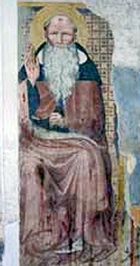Counter-façade
Administration of Justice (ca. 1371?)
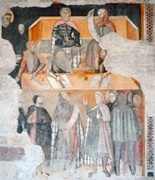
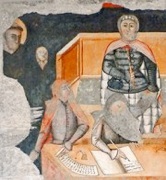
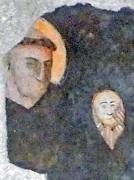
Surviving fresco fragment Detail 1 Detail 2
This damaged but historically important fresco to the right depicts St Nicholas of Tolentino (above and to the left) invigilating at an administrative event. This may well have been the reforming of the city statutes in 1371 at the behest of the Papal Legate, Cardinal Pierre d'Estaing and the Rector of the Patrimony of St Peter, Nicolò Orsini. St Nicholas, who lived in the latter part of the 13th century, is shown as a posthumous invigilator, and holds what is presumably a death mask (see detail 2 above). His presence here might have been at the request of Nicolò Orsini.
Female saint (14th century)
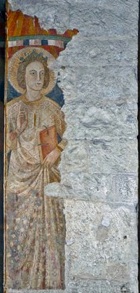
Madonna and Child with angels (ca. 1400)
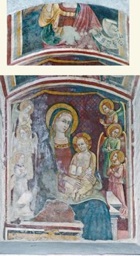
-
✴The niche was originally deeper, so only the lower half of a figure of the Redeemer survives on the upper surface. This includes the bleeding wound in His side.
-
✴The main panel depicts the upper part of a figure of the Madonna and Child enthroned with angels.
Left Aisle
Fresco (1236)
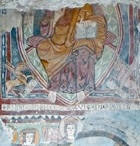
EGO /SUM /LUX / MUN/DI
I am the light of the world
A fragment of a fresco of the Madonna and Child enthroned with saints survives below: the heads of the Madonna and of another saint to her right survive, together with part of the mitre of an adjacent bishop saint.
Left Transept
St Antony Abbot enthroned (ca. 1400)
Crucifixion with St Peter (14th century)
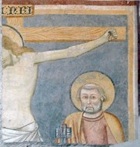
Presbytery
Frescoes (ca. 1400)
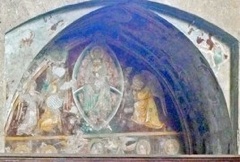
Corrado Fratini (referenced below) describes the frescoes on the walls of the seven chapels in the apse as they appeared in 1996. As he points out, these would have been easily visible from the nave before they were partially obscured by the choir stalls. Some of these (including those that survive - see below) are attributed to the Maestro di Narni del 1409 and others are attributed to the Maestro della Dormitio di Terni. Unfortunately, most of these are no longer visible. [Have they been detached?]
The surviving visible frescoes are in the 2nd chapel from the left: as noted above, they are attributed to the Maestro di Narni del 1409. They depict:
-
✴very damaged figures of the Annunciation, in the spandrels;
-
✴Christ in glory with angels, in the lunette;
-
✴the Madonna and Child with SS Francis, Andrew, Catherine of Alexandria and Paul in the middle register, of which only the upper part is visible; and
-
✴the Crucifixion and four scenes from the life of St Giles in the lower register, which is now completely hidden from view.
St Giles seems to have been the founder of a monastery at Saint-Gilles-du-Gard, which still possesses his presumed relics and which became an important pilgrimage site. The Angevins probably introduced the cult into southern Italy, and it might well have become popular in Narni during the period 1403-14, when the city was controlled by King Ladislas of Naples. This bay of the apse might well have been the location of the chapel dedicated to St Giles that was documented in 1407.
Right Transept
Frescoes (14th century)
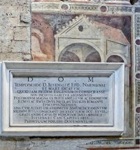
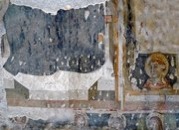
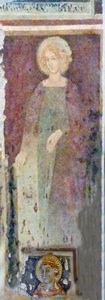
These frescoes on the left wall, to the right of the presbytery, depict:
-
✴a female saint in front of a tabernacle, part of which was obscured by an inscription set into the wall in 1728, with a fragmentary inscription along the bottom that reads MCCC....; and
-
✴four frescoes below it:
-
•the lower part of a saint enthroned;
-
•a standing female saint to the right of it;
-
•the face of a deacon (to the right of the enthroned figure and below the female saint); and
-
•heads of saints in tondi, which are now just above floor level.
Read more:
C. Fratini, “I Dipinti della Cattedrale di San Giovenale dal XIII Secolo al Primo Quattrocento e il Contesto Pittorico Narnese nel Tardo Medioevo”,
in C. Perissinotto (Ed.), “San Giovenale. La Cattedrale di Narni nella Storia e nell' Arte. Atti del Convegno di Studi (1996)”, (1998) Narni pp 201-25
Return to Interior
or proceed to: Sacello di San Cassio; or Chapels of San Giovenale.
Return to Monuments of Narni.
Return to Walk I.





















